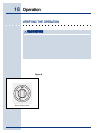
14
Installation
INSTALLING THE COOKTOP
Place and center the cooktop within the cutout. Secure the cooktop to the
countertop utilizing the two (2) 1/4-20 bolts provided. Do not overtighten the
screws.
CONNECTING THE GAS
Attach the gas pressure regulator (included with the cooktop) to cooktop pipe nipple
inlet.
Install a gas shut-off valve (not included with the cooktop) in the main gas supply
line in an accessible location near the cooktop. Complete connection of the gas
supply to the cooktop by installing 1/2 inch flexible gas line (not included with the
cooktop) between the pressure regulator and the shut-off valve.
WARNINGWARNING
WARNINGWARNING
WARNING
•The maximum gas supply pressure to the regulator must not exceed 1/2 pound
per square inch.
•Verify that the proper gas supply has been provided.
•Do not apply excessive pressure when tightening connections and fittings.
•Do not use plumber’s putty or Teflon tape on gas compression connections. It
can defeat the proper sealing of these fittings. Use plumber’s putty or Teflon tape
only on pipe thread fittings.
•Turn all cooktop control valves to the “OFF” position, then turn on the gas
supply. Check all supply lines and connections for leaks using a soap and water
solution. Do not use a flame to check for leaks. After verifying that there are no
gas leaks, turn off the gas supply to the cooktop by turning the gas shut-off valve
to the off position. Leak testing of the appliance shall be conducted according to
the manufacturer’s instructions.
•For LP gas installations, the LP gas tank must have its own high-pressure
regulator. This is in addition to the pressure regulator supplied with the cooktop.
IMPORIMPOR
IMPORIMPOR
IMPOR
TT
TT
T
ANTANT
ANTANT
ANT
To prevent damage to the gas pressure regulator, install the regulator only after the
cooktop is mounted in its permanent position. Ensure that the arrow on the regulator
points in the direction of the gas flow towards the cooktop.
IMPORIMPOR
IMPORIMPOR
IMPOR
TT
TT
T
ANTANT
ANTANT
ANT
Do not use a hardening compound or caulking to permanently seal the cooktop into
place, as the unit must be readily removable for service. If such a hardening compound
is used, removal of the unit will be at the customer’s expense.


















